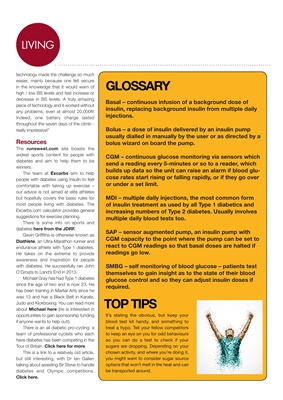
LIVINGLIVING
This amazing piece of technology made
the challenge so much easier, mainly
because one felt secure in the knowledge
that it would warn of high / low BS levels
and fast increase or decrease in BS levels.
A truly amazing piece of technology and
it worked without any problems, even
at almost 20,000ft! Indeed, one battery
charge lasted throughout the seven days
of the climb - really impressive!"
Resources
runsweet.com This site boasts the
widest sports content for people with
diabetes on the web in its aim to help
athletes with diabetes to be winners.
excarbs.com The team at Excarbs
aim to help people with diabetes using
insulin to feel comfortable with taking
up exercise - our advice is not aimed
at elite athletes but hopefully covers the
basic rules for most people living with
diabetes. The excarbs.com calculator
provides general suggestions for exercise
planning. JDRF Some info on sports and
diabetes can be found here from the
Juvenile Diabetes Research Foundation.
Gavin Griffiths is otherwise known as
Diathlete, an Ultra-Marathon runner and
endurance athlete with Type 1 diabetes.
He takes on the extreme to provide
awareness and inspiration for people
with diabetes. He successfully ran John
O'Groats to Land's End in 2013. Michael
Gray has had Type 1 diabetes since the
age of two and is now 23. He has been
training in Martial Arts since he was 13
and has a Black Belt in Karate, Judo and
Kickboxing. You can read more about him
here; he is interested in opportunities to
gain sponsorship funding. All diabetic
pro-cycling: a team of professional
cyclists who each have diabetes has
been competing in the Tour of Britain.
Click here for more. This is a link to a
relatively old article, but still interesting,
with Dr Ian Gallen talking about assisting
Sir Steve to handle diabetes and Olympic
competitions. Click here.
GLOSSARY
Basal - continuous infusion of a background dose of
insulin (replaces background insulin from multiple daily
injections
Bolus - a dose of insulin delivered by an insulin pump
usually dialled in manually by the user or as directed by a
bolus wizard on board the pump.
CGM - continuous glucose monitoring via sensors which
sent a reading every 5-minutes or so, which builds up
data so the unit can raise an alarm if blood glucose rates
start rising or falling rapidly, or if they go over or under a
set limit.
MDI - multiple daily injections, the most common form
of insulin treatment as used by all Type 1 diabetics and
increasing numbers of Type 2 diabetes. Usually involves
multiple daily blood tests too.
SAP - sensor augmented pump, an insulin pump with
CGM capacity to the point where the pump can be set to
react to CGM readings so that basal doses are halted if
readings go low.
SMBG - self monitoring of blood glucose - patients test
themselves to gain insight as to the state of their blood
glucose control and so they can adjust insulin doses if
required.
TOP TIPS
It's stating the obvious, but keep your
blood test kit handing, and something
to treat a hypo, and tell your fellow
competitors to keep an eye on you for odd
behaviours so you can do a test to check
if your sugars are dropping. Depending
on your chosen activity, and where you're
doing it, you might want to consider sugar
source options that won't melt in the heat
and can be transported around.